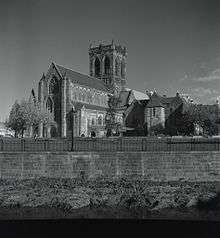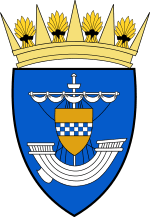Renfrewshire
| Renfrewshire Renfrewshire Siorrachd Rinn Friù | ||
|---|---|---|
 | ||
| ||
| Coordinates: 55°49′47″N 4°32′34″W / 55.829858°N 4.542838°WCoordinates: 55°49′47″N 4°32′34″W / 55.829858°N 4.542838°W | ||
| Admin HQ | Paisley | |
| Government | ||
| • Body | Renfrewshire Council | |
| • Control | SNP minority (council NOC) | |
| • MPs | ||
| • MSPs | ||
| Area | ||
| • Total | 101.0 sq mi (261.5 km2) | |
| Area rank | Ranked 24th | |
| Population (mid-2017 est.) | ||
| • Total | 176,800 | |
| • Rank | Ranked 10th | |
| • Density | 1,750/sq mi (676/km2) | |
| ONS code | S12000038 | |
| ISO 3166 code | GB-RFW | |
| Website |
www | |
Renfrewshire (/ˈrɛnfruːʃɪər,
Renfrewshire contains many of Glasgow's commuter towns and villages, including the town of Paisley, which is the area's main settlement and centre of local government, and the traditional county town of Renfrew, from which its name derives. The village of Elderslie is also notable as the traditional birthplace of Scottish knight William Wallace.
History
Present day Renfrewshire borders the south-west of Glasgow and contains many of Glasgow's commuter towns and villages. Renfrewshire also has boundaries with North Ayrshire, East Renfrewshire, Inverclyde and West Dunbartonshire. Although by area one of Scotland's smallest unitary authorities (excluding the cities), it is one of the country's most populous areas, being the fifth largest unitary authority and the ninth largest including the city authorities.
The ancient county of Renfrewshire covered a larger area — including both Inverclyde and East Renfrewshire. This area still exists in the form of a lieutenancy area and registration county, and has a statutory funding board called the Renfrewshire Valuation Joint Board. The county was traditionally based around its seat, the Royal Burgh of Renfrew and as such was also known as the County of Renfrew.
There was also a district named Renfrew which existed between 1975 and 1996. Renfrew District covered a slightly larger area than the present local authority area, and included the towns of Barrhead, Neilston and Uplawmoor, which, following the abolition of Strathclyde Regional Council region in 1996, were transferred into the new East Renfrewshire unitary local authority.
Renfrewshire Council Executive

Renfrewshire Council (Scottish Gaelic: Comhairle Shiorrachd Rinn Friù) is the elected local authority for Renfrewshire, which is one of 32 local council areas in Scotland. The council is based at Renfrewshire House in Paisley.
Renfrewshire Council recently (2011) won more awards than any other council in Scotland at the CoSLA Awards ceremony—winning three gold awards (out of seven) with a further three silver awards.[1] This is the highest number of awards ever won by a single Scottish council since CoSLA started handing out its awards.[2]
Renfrewshire Council is administered by the Scottish National Party. The Provost of Renfrewshire (the council's ceremonial head and convenor) is Lorraine Cameron, while the leader the council and largest political grouping is Iain Nicholson of the Scottish National Party, elected following the 2017 Renfrewshire local council elections.[3]
The council's apolitical employed service is headed by a Chief Executive, who is responsible to the elected council for the delivery of its policies. This executive wing is divided into seven departments: the Chief Executive's Department, Finance and Corporate Services, Education and Leisure Services, Environmental Services, Housing and Property Services, Planning and Transport, and Social Work.[4] Each department is headed by a Director, who is also an apoliticaCul, paid member of staff.[5]
Transport

Renfrewshire is home to Scotland's second busiest airport, Glasgow International Airport, at Abbotsinch between Paisley and Renfrew. It is served by the M8 motorway, which terminates in the area, just east of Langbank, and is a major artery between northwest and southwest Scotland, via the Erskine Bridge.
The presence of the airport and the proximity to Glasgow means that Renfrewshire supports one of the busiest transport infrastructures in Scotland, and is frequently congested.
Developments to ease traffic flow have included a lifting of tolls on the Erskine Bridge, plans to extend the rail network to connect to the airport, and the M74 extension – which will handle traffic from Renfrewshire heading south, diverting it away from Glasgow city centre.[6]
Renfrewshire also has bus links provided by First Buses, McGill's and other smaller operators.
Places of interest and events
Places of interest include the historic Castle Semple Loch at Lochwinnoch which is part of the Clyde Muirshiel Regional Park, Coats Observatory in Paisley, the Erskine Bridge, the country park at Gleniffer Braes, south of Paisley, St Mirren Park (home of St Mirren F.C.), Muirshiel Country Park, Paisley Abbey and the Weaver's Cottage at Kilbarchan, in the care of the National Trust for Scotland.
The Braehead Arena in Renfrewshire close to the boundary with Glasgow is home to leading professional basketball team, the Scottish Rocks, who compete in the British Basketball League. The arena was also host to the 2000 Ford World Curling Championships.
Education

Renfrewshire has 11 secondary schools, 51 primary schools and 3 schools for children with additional support needs. Further education is provided by Paisley Campus of West College Scotland in Paisley, which caters to around 20,000 students. The college also has sites in Inverclyde and West Dumbartonshire.[7]
The University of the West of Scotland is the single higher education provider in Renfrewshire; a new university the UWS was granted university status in 1992 as the University of Paisley. Prior to this, the Paisley Technical College and School of Art was a Central Institution or polytechnic. In 2007 the university merged with Bell College, a further education college in Hamilton, South Lanarkshire and the UWS name was adopted. The university today has sites across the west of Scotland, notably also in Ayr and a joint campus in Dumfries; the main campus remains in Paisley.
As of 2017, the director within Renfrewshire Council responsible for all aspects of educational provision across Renfrewshire is Peter McLeod in his capacity as Direction of Children's Services.[8] In addition to being responsible for all aspects of educational provision, the Director of Children's Services is also responsible for areas such as the children's social work department and the criminal justice social work department.[9] Current educational priorities within Renfrewshire include the tackling of poverty in childhood and education, raising the educational attainment in children, addressing inequalities relating to health and social aspects and ensuring all children in Renfrewshire reach their full potential.[10]
Towns and villages
Politics
Following the results of the United Kingdom general election, 2015 and Scottish Parliament election, 2016, all of Renfrewshire's parliamentarians are Scottish National Party, with the council administered by an SNP minority administration, elected in the Scottish local elections, 2017.
Current composition (2017–present)
| Party | Councillors | |
| Scottish National Party | 19 | |
| Labour | 13 | |
| Scottish Conservative Party | 8 | |
| Independents | 2 | |
| Liberal Democrat | 1 |
Previous compositions
2012–2016
| Party | Councillors | |
| Labour | 22 | |
| Scottish National Party | 15 | |
| Liberal Democrat | 1 | |
| Scottish Conservative Party | 1 |
As such, the election resulted in the Scottish Labour Party gaining full control of the Renfrewshire Council.
2007–2012
There was no overall party in control of Renfrewshire Council so therefore a Scottish National Party/Scottish Liberal Democrats coalition was formed to run the council for that four-year period (2007–2012).
2003–2007
Following the previous council elections in 2003, prior to the introduction of a proportional representation system in council elections across Scotland, Renfrewshire Council was administered by a Labour majority. The results were:[11]
| Party | Councillors | |
| Labour | 21 | |
| Scottish National Party | 15 | |
| Liberal Democrat | 3 | |
| Conservative | 1 |
Electoral wards
For the purposes of elections to Renfrewshire Council, the Renfrewshire area is divided geographically into a number of wards which then elect either three or four councillors each by the Single Transferable Vote system. The electoral system of local councils in Scotland is governed by the Local Governance (Scotland) Act 2004, an Act of the Scottish Parliament which first introduced proportional representation to councils. These electoral wards, as defined in the Renfrewshire (Electoral Arrangements) Order 2006 (SSI 2006/551)[12] are as follows:
Ward 1 – Renfrew North (3 councillors)
Ward 2 – Renfrew South & Gallowhill (3 councillors)
Ward 3 – Paisley East & Ralston (4 councillors)
Ward 4 – Paisley North West (4 councillors)
Ward 5 – Paisley South (4 councillors)
Ward 6 – Paisley South West (4 councillors)
Ward 7 – Johnstone South, Elderslie & Howwood (4 councillors)
Ward 8 – Johnstone North, Kilbarchan & Lochwinnoch (3 councillors)
Ward 9 – Houston, Crosslee & Linwood (4 councillors)
Ward 10 – Bishopton, Bridge of Weir & Langbank (3 councillors)
Ward 11 – Erskine & Inchinnan (4 councillors)
Scottish Parliament
Renfrewshire is represented by three constituencies in the Scottish Parliament: Renfrewshire North and West (Derek Mackay), Paisley (George Adam) and Renfrewshire South (Tom Arthur).
Westminster Parliament
The two constituencies covering Renfrewshire in the Westminster Parliament are Paisley and Renfrewshire North and Paisley and Renfrewshire South. The constituencies are represented by Gavin Newlands and Mhairi Black respectively.
Referendum results
Renfrewshire rejected independence in the 2014 Scottish Independence referendum, with 55,466 (47.2%) votes cast in favour and 62,067 (52.8%) against, on a high turnout of 117,612 (87.3%).
With a turnout of 69.2% (88,197), Renfrewshire strongly voted remain in the 2016 European Union membership referendum with 64.8% (57,119) of votes cast in favour of remain against 35.2% (31,010) votes in favour of leave.
References
- ↑ "Paisley News". Paisleydailyexpress.co.uk. Retrieved 2015-12-12.
- ↑ "therealmackay". Therealmackay.org. 2014-08-09. Retrieved 2015-12-12.
- ↑ http://www.renfrewshire.gov.uk/article/4974/Key-appointments-made-at-first-Renfrewshire-Council-meeting-of-new-session
- ↑ "Renfrewshire Community" (PDF). Renfrewshire.gov.uk. Archived from the original (PDF) on 2012-02-18. Retrieved 2015-12-12.
- ↑ Archived August 28, 2012, at the Wayback Machine.
- ↑ Archived June 23, 2006, at the Wayback Machine.
- ↑ Archived July 24, 2011, at the Wayback Machine.
- ↑ http://www.renfrewshire.gov.uk/article/2290/Childrens-Services
- ↑ http://www.renfrewshire.gov.uk/article/2290/Childrens-Services
- ↑ http://www.renfrewshire.gov.uk/article/2290/Childrens-Services
- ↑ Archived September 11, 2008, at the Wayback Machine.
- ↑ "The Renfrewshire (Electoral Arrangements) Order 2006". Opsi.gov.uk. 2011-07-04. Retrieved 2015-12-12.
External links
- Renfrewshire at Curlie (based on DMOZ)
- Renfrewshire Events Guide
- Paisley Daily Express local daily newspaper
- The Gazette Newspaper weekly
- Renfrewshire24.co.uk, online only news and events website
